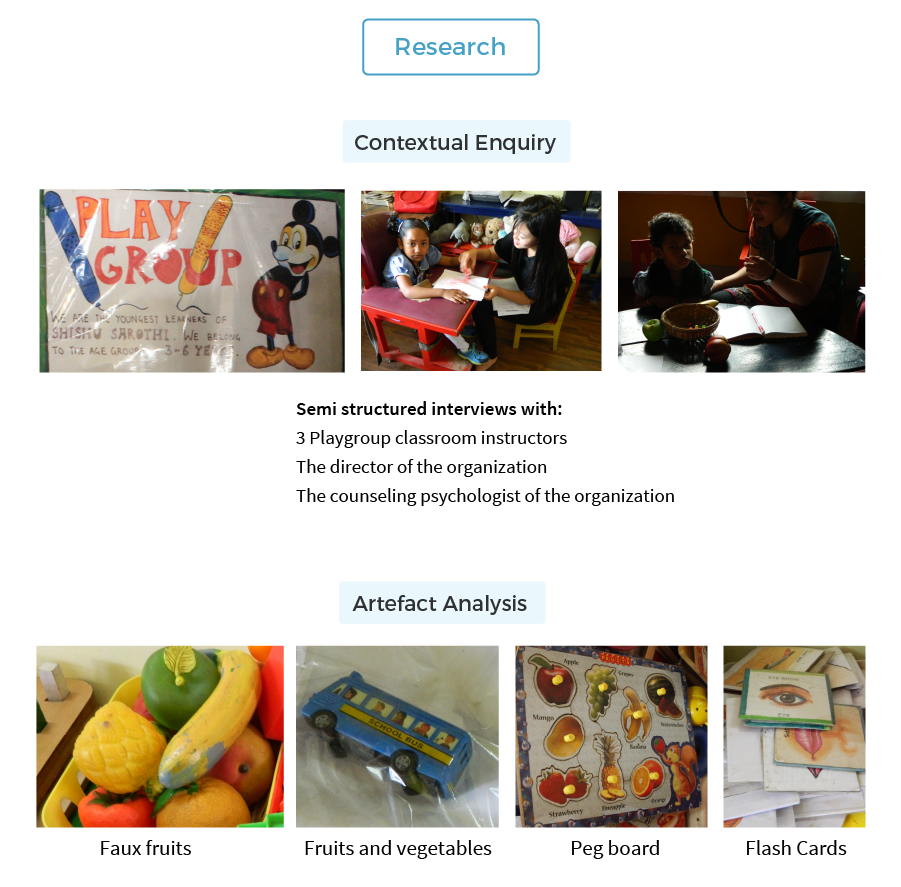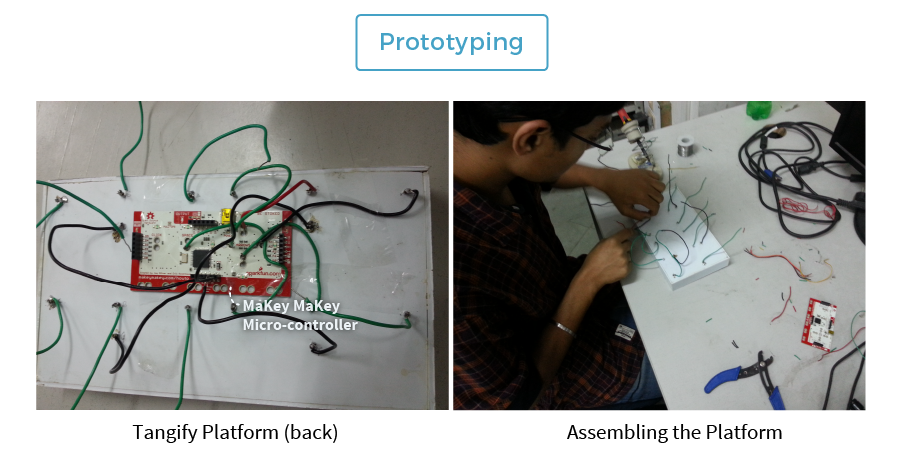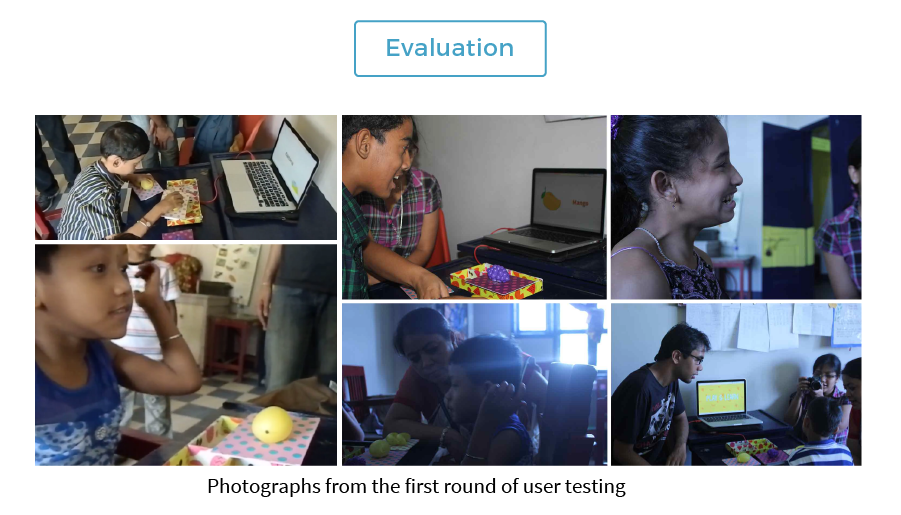Tangify: A multimodal learning toolkit for specially abled children
Tangible User Interface
Brief
The project was carried out in a team of 4 as part of the academic course, ‘Tangible User Interfaces’. The project started with a field visit to Shishu Sarothi, a rehabilitation centre for specially abled people in Guwahati. We decided to target the ‘Playgroup’ which a class of 3 to 7 year old specially abled children with Autism Spectrum Disorders (ASD), Cerebral Palsy, Down’s Syndrome and Attention Deficit Hyperactivity Disorder (ADHD). We studied about the disorders and conducted a contextual enquiry.
After identifying some pain points, we brainstormed and made a high fidelity prototype of Tangify.
When the tokens (fruits) are placed in the slots of the Tangify platform, the computer gives audio and visual cues relevant to the token based upon the slot it was placed in. The system can also ask the children some questions and then the children place the corresponding token on the platform. Tangify is a scalable concept that can be expanded to teaching about other things like colours, shapes, vegetables etc.
Tangify was a great learning experience for me as it allowed me to design for specially abled users, a totally new user group for me. Prototyping Tangify, evaluating it with the children and watching their million dollar smiles as they interacted with Tangify was a proud moment.
 About 10% of the world population is living with some form of disability. Teaching cognitively impaired children requires a lot of repetition from the teacher’s end. Teaching only the numbers 1 & 2 can take as long as 2 months. We decided to make an intervention as an attempt to reduce the teacher’s effort and to improve the learning curve of the children.
About 10% of the world population is living with some form of disability. Teaching cognitively impaired children requires a lot of repetition from the teacher’s end. Teaching only the numbers 1 & 2 can take as long as 2 months. We decided to make an intervention as an attempt to reduce the teacher’s effort and to improve the learning curve of the children.
Tangify is a multimodal interactive toolkit developed for specially abled children in the age group of 3 to 7 years to teach them about everyday objects.
 The project started with field a visit to Shishi Sarothi, a rehabilitation & training centre for specially abled persons located in Guwahati. We decided to focus on their ‘playgroup’ which carried out activities conducted in pre-schools or in the playgroup wing of a regular school but the special needs are always given importance.
The project started with field a visit to Shishi Sarothi, a rehabilitation & training centre for specially abled persons located in Guwahati. We decided to focus on their ‘playgroup’ which carried out activities conducted in pre-schools or in the playgroup wing of a regular school but the special needs are always given importance.
A literature review was conducted by to develop a better understanding of the target users and have a look at the existing interventions.
Silent Observation: Observed the environment and how the children were interacting among selves and with the teachers. The class had 18 students and 3 teachers which could attend only 1 student at a time.
Artefact Analysis: Observed the toys, flash cards and apparatus being used. We observed that the teacher’s taught the children about everyday objects through like vegetables using artificial vegetables or flash cards. To teach children about objects, the teacher presented the student the artificial object or flash card, repeatedly recited the object’s name. The extensive repetition by the teacher, done on a one to one basis with the children requires a lot of effort.
Contextual Enquiry: Interviewed 5 stakeholders including 3 teachers, the psychologist and the director of the organization to understand how they work and the problems they were facing. The interviews were open ended and guided by a questionnaire. Also participated with the children in various activities in the classroom and assisted the teachers.
 After the research we had an understanding of the target user group. The biggest problem with the current teaching mechanism was the extensive need of repetition from the teachers end. The learning experience isn’t multi modal either. After understanding the teachers' activities and identifying problems, we brainstormed and came up various solutions. After filtering the solutions, decided to go ahead with Tangify.
After the research we had an understanding of the target user group. The biggest problem with the current teaching mechanism was the extensive need of repetition from the teachers end. The learning experience isn’t multi modal either. After understanding the teachers' activities and identifying problems, we brainstormed and came up various solutions. After filtering the solutions, decided to go ahead with Tangify.
 Tangify composes of:
Tangify composes of:
Tangify Platform: An electronic board with 4 rectangular slots
Tangify Tokens: Hollow cuboids on which various fruits and vegetables may be attached
A computer: For giving audio and visual cues.
When the tokens are placed in slots of the platform, the computer gives audio and visual cues relevant to the token based upon the slot it was placed in. We decided to teach the children about fruits using artificial fruit as tokens.

The platform has four slots corresponding to the name of the fruit, the colour, the spelling and how it is drawn. The children pick a fruit and place it in one of the 4 slots. Corresponding to the action, an animated video is played back a few times.
If ‘grapes’ were placed in the ‘colour’ slot, the system would recite, ‘grapes are purple’ accompanied with visuals and music.

Tangify can ask questions like, ‘Which fruit is yellow?’ and the user would place a ‘banana’ in any of the slots. Tangify gives appraisals in form of audio-visual cues on the computer. If the student places the wrong fruit in the slot, they’re prompted and given another chance.
During our research, we identified that the teachers draw a star on the student’s notebook & clap if he performed well.

A high- fidelity prototype was made using a Makey-Makey micro controller connected to a laptop. Tangify is constrained to allow only one token to be placed on the platform. Each token has a metal plate at its base which completes a specific circuit of the Makey-Makey. This is read by Processing and the corresponding video is played back.
We learned during our research that artificial fruits are more effective while learning in comparison to printed flash cards & also the children are very fond of bright colours & animated videos.

We conducted the first round of user testing at Shishu Sarothi with 8 children belonging to the age group of 3-7. Tangify was put up in the classroom and children interacted with the system one by one and being given a first-hand demonstration. They were assisted by a teacher whenever required.
The children felt very joyful to see the animated videos with music on the screen whenever they placed a token on the Tangify platform. They were self-motivated to keep interacting with the system without much assistance from the teacher. Some children were also reciting along with the video.
Shortfall: During contextual enquiry, we learned that colourful objects attract children. However, during evaluation an expert teacher pointed out that the usage of polka dots on the Tangify tokens with fruits was not a very good idea as it made it visually a little harder for the special children to perceive the fruits attached to the tokens.
Conclusion
Tangify allows the children to engage with the system on their own without much assistance from the teachers. Though teachers intervention cannot be completely reduced due to the severity of the problem but our system aims at reducing the the effort of the teacher while making the learning process much more playful and engaging for children.
After the first phase of user testing the results were encouraging and we will continue to test it across for a reasonable amount of time and see if there is any improvement in the learning curve of students through Tangify. Currently the Tangify platform is used to teach only about fruits, however, if successful it can be expanded to other objects such as vegetables, stationary, number, shapes etc.
Acknowledgement
We would like to thank Prof. Keyur Sorathia for his guidance and supporting us with desired resources during the course of this project. We would also like to thank Shishu Sarothi for allowing us to conduct the study at their premises.
Duration
Jan '15 - May '15
Guide
Prof. Keyur Sorathia, Dept. of Design, IIT Guwahati
Project Tags
Tangible User Interfaces, Disabled Children